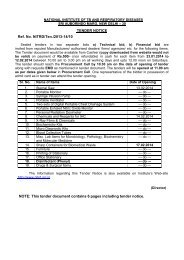The Indian Journal of Tuberculosis - LRS Institute of Tuberculosis ...
The Indian Journal of Tuberculosis - LRS Institute of Tuberculosis ...
The Indian Journal of Tuberculosis - LRS Institute of Tuberculosis ...
You also want an ePaper? Increase the reach of your titles
YUMPU automatically turns print PDFs into web optimized ePapers that Google loves.
22 G. RAGHUPATI SARMA ETAL<br />
regimens (during the initial intensive phase <strong>of</strong> 2<br />
months) :<br />
R-7: Rifampicin 450 mg plus Ethambutol 800 mg<br />
plus Isoniazid 300 mg plus Pyrazinamide 1.5 g<br />
daily.<br />
R-2: Rifampicin 450 mg plus Ethambutol 1.6 g<br />
plus isoniazid 600 mg plus Pyrazinamide 2.0 g<br />
twice-weekly.<br />
NR-7: Same as R-7 above, but without<br />
Rifampicin.<br />
None <strong>of</strong> the patients was diabetic or pregnant<br />
or on any form <strong>of</strong> steroid treatment at the time <strong>of</strong><br />
the investigation.<br />
Plasma cortisol and tetracosactrin stimulation test:<br />
Blood was collected between 08:00 and 08:30<br />
hours on admission and at 1, 2 and 4 weeks after<br />
the start <strong>of</strong> treatment, and plasma cortisol<br />
determined. <strong>The</strong> tetracosactrin stimulation test<br />
was performed on admission and at 4 weeks. On<br />
both occasions, blood was collected for the<br />
determination <strong>of</strong> the basal plasma cortisol and at<br />
l /2 hour and 1 hour after intramuscular<br />
administration <strong>of</strong> 0.25 mg (about 24 units) <strong>of</strong><br />
tetracosactrin (kindly donated by Hindustan Ciba<br />
Geigy Ltd). Plasma was separated and stored at -<br />
20°C till assay.<br />
<strong>The</strong> patients were classified as positive or<br />
negative responders to tetracosactrin, the<br />
criterion for a positive response being an increase<br />
in plasma cortisol <strong>of</strong> 200 nmol/1 or more at 1 /2<br />
hour and 1 hour over the respective basal level 1<br />
Diurnal variation <strong>of</strong> cortisol level : This was<br />
studied from changes in salivary cortisol on<br />
admission and at 2 months after the start <strong>of</strong><br />
treatment. Saliva was collected at 08:00 hour and<br />
then at 2-hourly intervals up to 20:00 hour. <strong>The</strong><br />
saliva specimens were frozen (kept at -20°C)<br />
overnight. <strong>The</strong>y were then thawed and<br />
centrifuged; the residue containing mucoproteins<br />
was discarded and the clear supernatant stored at<br />
-20°C till assay.<br />
Plasma cortisol was determined by a standard<br />
RIA technique employing commercially available<br />
cortisol assay kit (Amersham International pic,<br />
England), and salivary cortisol was estimated<br />
according to a method, adapting these kits,<br />
standardized at our Centre (unpublished).<br />
Student's t-test (paired and unpaired) was<br />
employed for testing the difference between the<br />
mean cortisol levels, the chi-square test with<br />
Yates' correction for continuity to test the<br />
differences between the proportions in the<br />
different treatment groups, and McNemar's test<br />
for testing the differences between the<br />
proportions within the same group at different<br />
time-points.<br />
Results<br />
A total <strong>of</strong> 61 patients (54 male, 7 female) was<br />
admitted to the study; <strong>of</strong> these, 17 were allocated<br />
to the R-7 regimen, 23 to the R-2 regimen and 21<br />
to the NR-7 regimen. Four patients (1 R-7,1 R-2,<br />
2 NR-7) were excluded from the analysis due to<br />
culture negativity on admission, inadequate (<<br />
80%) chemotherapy or failure to attend on one<br />
or more <strong>of</strong> the designated test-days. <strong>The</strong> analysis<br />
is therefore based on 57 patients (16 R-7, 22 R-2,<br />
19 NR-7). <strong>The</strong> culture grading for M. tuberculosis<br />
on admission was 3 + (confluent growth) in 35<br />
patients, 2 + (> 100 colonies) in 19, 1 + (20-100<br />
colonies) in 2 and less than 20 colonies in 1<br />
patient.<br />
Plasma cortisol levels : <strong>The</strong> mean basal plasma<br />
cortisol levels (08:00 hour) in the 3 groups, on<br />
admission and at 1, 2 and 4 weeks after the start<br />
<strong>of</strong> treatment are presented in Table 1 and Figure<br />
1. <strong>The</strong> mean values were similar in the 3 groups<br />
on admission. In the R-7 patients, the mean<br />
plasma cortisol at 1 week was about 24% higher<br />
(P = 0.06) than on admission. Further treatment<br />
caused a decrease in the levels and the mean<br />
value at 4 weeks was about 14% less than that at 1<br />
week, and similar to that on admission. In the<br />
NR-7 patients too, the mean value at 1 week was<br />
about 11% higher (P - 0.06) than that on<br />
admission and further treatment caused a<br />
decrease and the mean value at 4 weeks was<br />
about 21% less than that at 1 week (P < 0.01);<br />
the difference between the mean values on<br />
admission and at 4 weeks (12%) was also<br />
significant (P < 0.01). <strong>The</strong>re was practically no<br />
change in the mean basal plasma cortisol values<br />
at different weeks in the R-2 patients.<br />
At 1 and 2 weeks, only the mean value in the<br />
R-7 patients was significantly higher than that in<br />
the R-2 patients (P = 0.01 and 0.04, respectively),<br />
and at 4 weeks,, only the mean value in the R-7

















